#dwarves seem pretty solid on dwarf magic specifically
Explore tagged Tumblr posts
Text
One of the funny things about LotR is that almost every people in it professes to disbelieve in the supernatural, but because they live in a fantasy world their baseline for "natural" is so jacked up. The Rohirrim are like, yeah, there's a wizard in this tower and ancient tradition that we have no reason to doubt says this mountain is full of ghosts, but walking trees? Short people? I don't think so. Galadriel is like, "Listen I heard you describe what I do as magic and look I just gotta clear some things up, okay." Gondorians are like, yeah, of course the Enemy has spectres of men who lived long ago and never died and can now fly above us and incapacitate us with just their voices. This is just a fact of life, okay? But shut up about this magic weed that makes comatose people better. That's an old wives' tale. Royalty? Press X to doubt.
The people group in Tolkien's work who seem most receptive to magic and least restricted by their own notions of what it can do actually seem to be the hobbits. And they use it to avoid meeting people they don't want to talk to
#lotr#dwarves seem pretty solid on dwarf magic specifically#we dont really get many dwarf opinions on other sorts of magic
19K notes
·
View notes
Text
Moral Support: Full Commentary
Welcome to the full card commentary! This card contest was mechanically fairly prescriptive in some major ways, so I was pretty pleased to see such a wide range of approaches. Thanks so much for all of your submissions! They were a blast to read, and I hope you’ll check out what everybody produced this week. - @teaxch
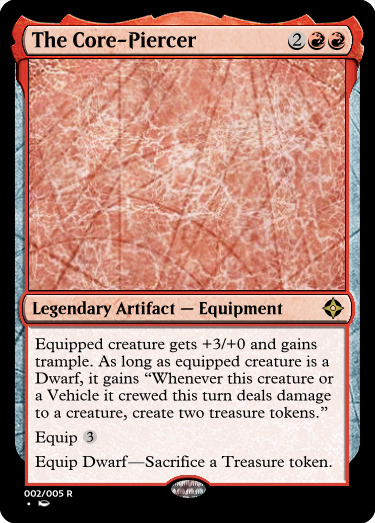
@abzanhero - The Core-Piercer
This card combines several things that Dwarf cards have cared about in the past in a fairly elegant way. On a creature, an ability that wants you to deal damage to creatures and trample have mild tension, but it’s less of an issue on an equipment, which can be used on both offense and defense. I’m not sure if I get the flavor of specifically getting treasure when a creature is damaged, but the “big drill” making treasure is sensible enough.
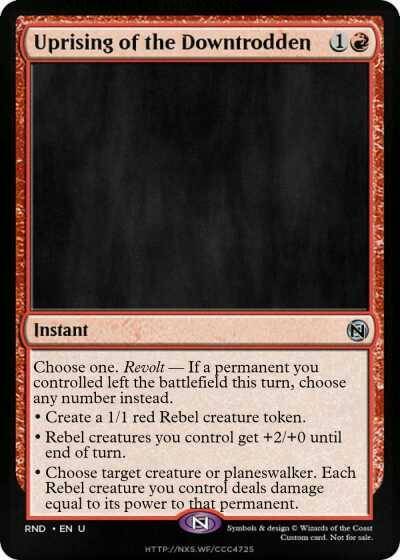
@alextfish - Uprising of the Downtrodden
I went back and forth on this card. Specifically, Revolt cards tend to have the trait that they make sense when played after combat damage has been dealt, as that’s the most common time that permanents leave play in many formats. A tribal Trumpet Blast isn’t generally useful played after combat damage. The card is pretty clever, however, in that it gives the power boost a function when played with Revolt. The design of the card is also clever in that the card may legitimately be worth running in a deck that lacks Rebel tribal in limited, as it’s still a Lightning Strike (at least for creatures and planeswalkers) that leaves a token behind with Revolt, which is solid.
There’s no special synergy with the existing Rebel mechanic other than that Rebels are good at getting multiple creatures onto the board, but the Rebel mechanic has some play issues, so it’s reasonable that they’d probably go in another direction if they brought the type back.

@bread-into-toast - Spray of Strikes
I love this as a Hydra-themed card design. Hydra’s don’t have a long history of fighting multiple things, but it makes a lot of sense as a place for the creature type to go.
While it’s very slightly different, I suspect that this may be templated as “Target creature you control deals damage equal to its power to each of X target creatures your opponents control. Each of those creatures deals damage equal to its power to that creature,” or something along those lines. It’s a lot clunkier, but it avoids confusion about whether your creature can die before all of the fights happen. (It cannot; even if it takes damage greater than or equal to its toughness, state-based actions will not be checked until the card resolves completely.)
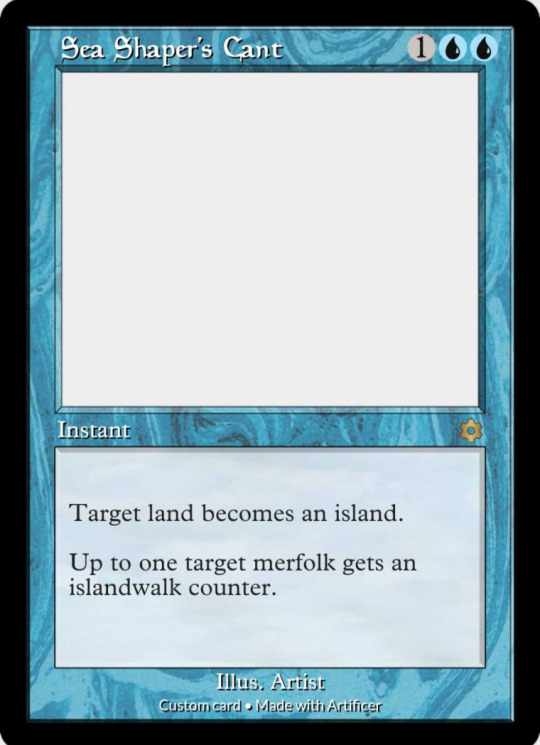
@chungus-supreme - Sea Shaper’s Cant
Permanent unmarked changes to land types aren’t unheard of, but they are uncommon; unless there’s a specific environment reason that this must be an instant, I feel like this could be implemented as an aura with Enchant Land, Flash, and an ETB ability that puts an Islandwalk counter on a Merfolk.

@corporalotherbear - Threefold Sun’s Zenith
This card has a very clever Modern Horizons-style concept, tying the Threefold Sun to the Sun’s Zenith cycle. You have to invest a ton into this card before it starts to approach a good deal, but that fits in reasonably with the general go-big strategy that dinosaur decks typically have. I think that the decision to avoid tying the effects directly to the three-card Sun’s Avatar cycle makes sense; there’s not really an obvious way to scale the white one’s effect.
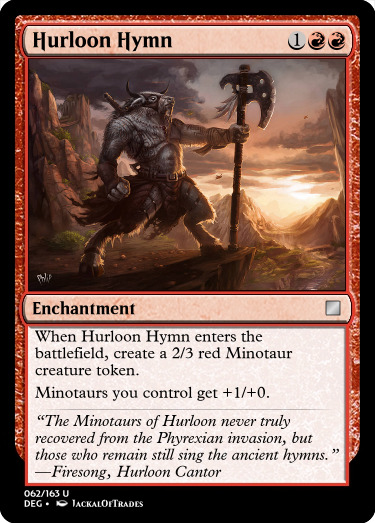
@deg99 - Hurloon Hymn
The global enchantment that makes a single token on ETB isn’t a commonly used design tool - typically they just attach the enchantment effect to the creature directly (which also makes it easier to remove.) This is a reasonable application of the technology, in the vein of Liliana’s Mastery. I like the connections to both very old and more recent lore in the name and flavor text.

@demimonde-semigoddess - Crash the Workshop
I’m assuming that, based on the implied Kaladesh setting, that this card is from an artifact-heavy set, which I think is pretty important to its design. In an environment without many targets, this is a moderately swingy (and potentially frustrating) sideboard card at best, and also potentially misleading - you don’t want to maindeck this card in a typical limited environment no matter how many Gremlins you have. Fortunately, that’s likely not a concern.
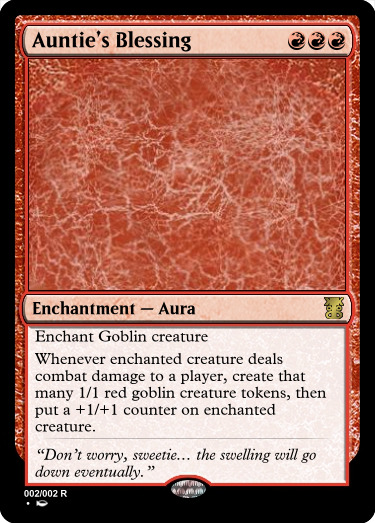
@dimestoretajic - Auntie’s Blessing
I think this card is really interesting in that it uses a creature type restriction to focus less on something that the tribe is good at and more as a limitation based on what the tribe typically isn’t that great at. This aura is strongest when it’s on a large, evasive creature, and goblins are typically neither. That helps keep the snowball potential of this card in check. I do think that this card could be less color-intensive; triple red is a lot to ask when the card already has several hoops to jump through. (On the other hand, many Goblin decks historically have been mono-red; this is more of an issue if Goblins are also in another color, e.g., black, and for limited.)
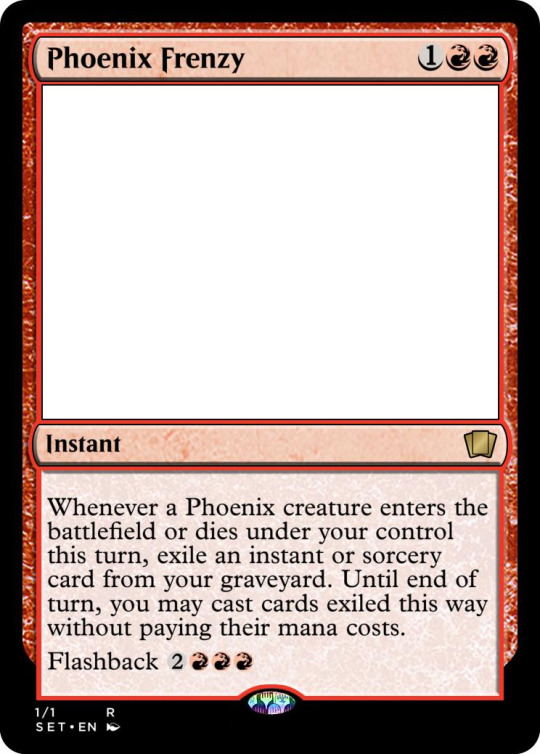
@gayagendaofficial - Phoenix Frenzy
Phoenixes have a little bit of history with instants and sorceries, including multi-format star Arclight Phoenix, so while this card only touches indirectly on Phoenixes’ most prominent gimmick, it still makes a degree of sense. This card becomes very interesting and complex if you have the ability to trigger it multiple times in a turn (the ease of doing so varies widely with the number of Phoenixes in the environment), because it allows you to cast the same card from your graveyard multiple times in a turn, including itself, provided you can supply multiple Phoenix triggers. Cards that let you cast instant and sorcery cards from your graveyard in some fashion typically include some clause that keeps them from being used more than once. The fairly major Phoenix-related limitation may be sufficient to make this unnecessary, but given that this card is in a set that has Flashback already, it could give the spells Flashback 0 instead of letting you cast them from exile, if that’s something you wanted to avoid.
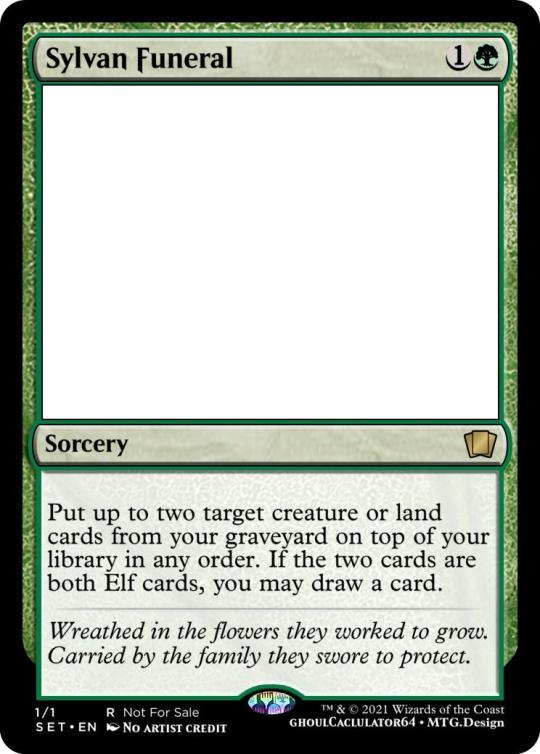
@ghoulcaclulator64 - Sylvan Funeral
This card is on the lower end of value if you’re not getting the tribal effect, although accepting a bit of card disadvantage to get your bomb back is something that could plausibly be worth it in limited. This card could probably be bumped up a whisker; Find/Finality is a rare, but Survivors’ Bond, which compares favorably to this card, is just a pretty good common.
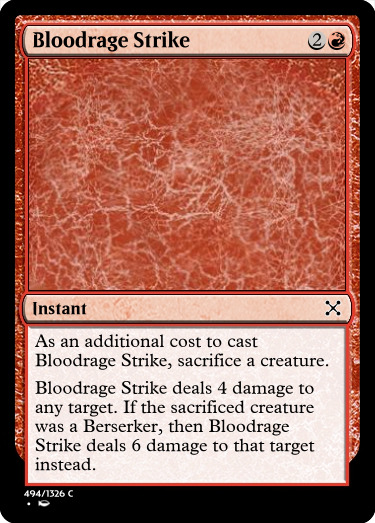
@gollumni - Bloodrage Strike
Commons are hard to pull off in the Fair in the best of times (well, except for weeks like the current week, where being common is required). They tend to not be as splashy or novel, and this week in particular lent itself to more complex designs. That said, I appreciated this common’s elegance enough that it only just missed the winner’s circle. An effect like this has never been done quite so simply or elegantly; there are a few cards that care about the type of the sacrificed creature, but in all cases it’s a component of a more complex card.
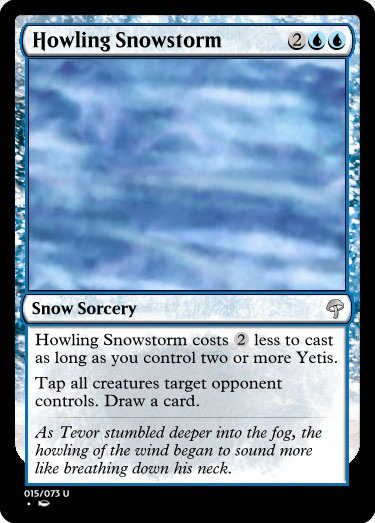
@grornt - Howling Snowstorm
Yetis don’t have a strong existing mechanical identity, so this is as good as any. The Yeti bonus here is pretty tame, as this will generally be a card played later in the game (if not as a finisher entirely), but the discount is still good tempo. That this is a Cantrip is interesting as it encourages the use of the card to push through some damage mid-game, rather than only using it to close games out, which is the most common use of cards that tap all of your opponents’ creatures.
Currently, all printed Snow instants and sorceries care about snow mana or cards in some way, but not all Snow creatures or lands do, so that doesn’t seem to be a hard rule in general. (It appears that Kaldheim used the rule that only cards that care about Snow or produce mana are Snow, but other sets haven’t hewn to this.)

@hiygamer - Mining Rig
The decision to tie the treasure production specifically to tapped Dwarves is really smart on this card. It not only makes a certain amount of flavor sense and keeps fresh dwarves from immediately adding to your treasure total (unless they have Haste or help), but it pushes the deck to generally be active, rather than just playing a bunch of dwarves and doing nothing with them and winning a few turns later off of a giant spell.
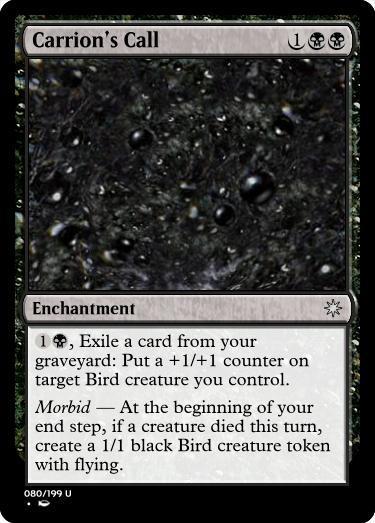
@hypexion - Carrion’s Call
Magic has done a bit of bird-graveyard interaction before, generally with the flavor of carrion birds, so even though Birds’ primary mechanical identity is just that they fly, this feels reasonably connected to the tribe, especially as it exists in black. This card is a nice “zero or more” tribal card, which isn’t something the contest naturally lends itself too, and the overall flavor package is very tight.
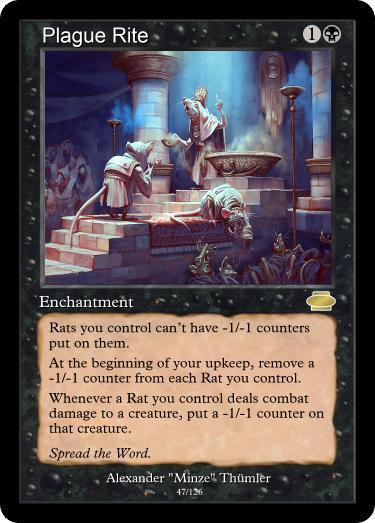
@i-am-the-one-who-wololoes - Plague Rite
While it’s common for triggered abilities to appear after static abilities, on this card that ends up burying the lede a bit; even in an environment very heavy on -1/-1 counters, the main selling point of this card is the third of the three abilities. That’s a fairly minor point, however. (The other abilities do combo with Everlasting Torment and things that grant persist, at least.)
Removing -1/-1 counters from your creatures (without moving them somewhere else) initially felt a little odd in black, but the overall package of the card sells the general idea of the counters being spread around. Additionally, black does have the little-used ability to remove arbitrary counters from permanents.

@ishmael-urquhart - Angelic Restoration
As near as I can tell, white’s never gotten a simple sorcery that just brings back a creature with low mana value, so this is a good find. In some ways, I wish that the two options for this card were more parallel, rather than one bringing the creature back to the battlefield and one putting it into your hand, although I’m not sure if the card could cost three mana if it could bring back any Angel to the battlefield. Currently, the second of the two options is a bit overcosted, but it’s still something you’re realistically choose late game some of the time.
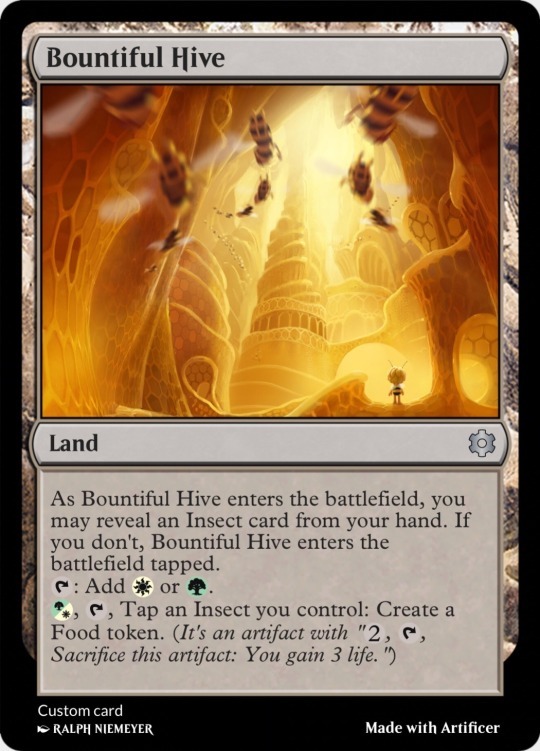
@jsands84 - Bountiful Hive
This card very barely missed the Winners’ Circle cut. This is a new mechanical identity for insects, but it’s one that makes sense for insects in green and white, which is an especially appropriate color pair for social insects, like those printed on the card. (Also, Insects don’t have a terribly strong existing color identity.) This card could probably be a rare; the Lorwyn tribal reveal lands probably don’t have to be rares, but adding the extra ability might push it there.
Minor nitpick - I’m assuming that the last ability should read “tap an untapped insect...”

@lesbian-verdeloth - Stand Against Tyranny
Not many people submitted Tribal cards, but this one certainly merits the type. It’s largely doing the same trick as Bound in Silence, a card that I personally consider the single best and most interesting deployment of the Tribal card type, but on a card that more directly supports the Rebel game plan. If anything, this may support the Rebel game plan a little too well; the mere threat of this card makes it hard to profitably interact with a Rebel deck’s board as long as a card that can search for a Rebel 3-drop is on the board.

@loreholdlesbian - Lycanthropy//Form of the Alpha Wolf
This card has some good flavor, although it’s very complex. A “Form of the Dragon” card for being a Werewolf is really clever, and a DFC that uses the established werewolf mechanic is a great way to sell what’s going on.
I think the card may be a bit on the weak side. The turn you play it, it basically just gives you a 1/1 and halves your life total, which isn’t great for three mana. It generally won’t transform until the beginning of your opponent’s upkeep three turns after it was played, if you forgo playing anything on your next turn. While this is how all cards with the Werewolf mechanic work, generally the front side of a Werewolf card is at least a mediocre creature for its cost.
The back half of the card is also somewhat complex in terms of nesting ability dependencies. If you control a 3-power human creature when the card transforms, there’s a three-deep nesting of abilities determining your new life total. That’s not something alien to Magic, but it’s rare that it’s all on the same card.

@maizenolo - Statue Garden
I’m legitimately not sure if the game rules can recognize “Destroyed by a Gorgon” - that seems to be new technology, and I’m not sure whether there are rules issues with it. Assuming it works, this is a cool and flavorful thing for Gorgons to be doing.
I’m not sure if the ability is the sort of thing that necessarily goes on a land; lands rarely have repeatable, board-affecting triggered abilities of this sort. A statue garden is a place, but I would generally expect to see this effect on an artifact or enchantment.

@misterstingyjack - Renais, Prince of Beasts
Because the contest for this week disallowed creature cards, there were a limited number of ways to make cards that could take advantage of their own tribal effects. Making tokens is the easiest, but this approach is also very cool. This design also allows for a very highly tribal planeswalker (none of the loyalty abilities do anything without beasts) that’s still functional on its own.
The first ability may need to read “number of loyalty counters on him,” but that’s just a minor templating issue.
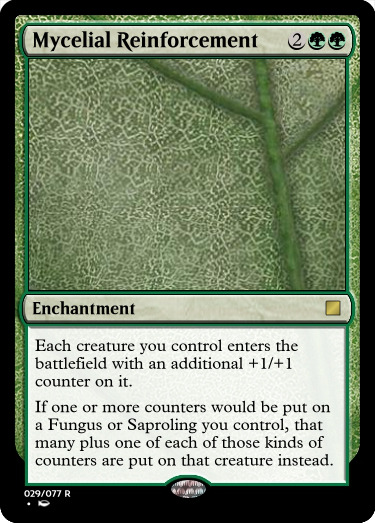
@morbidlyqueerious - Mycelial Reinforcement
The tribal Winding Constrictor effect plays very well with both the spore counter mechanic historically associated with fungi and with the general Doubling Season strategy that the tribe tends to adopt in Commander. There’s potential for slight rules confusion with cards like Ghave (Ghave enters with only one extra counter), but decks that play cards of this sort already potentially deal with that interaction, so that may not be that big of a deal.

@naban-dean-of-irritation - Vantrian Tactics
Even with just a few available targets, this is a fairly decision-dense card; the number of possible permutations grows pretty quickly. That’s not unique among Magic cards, but this card asks the player to make the decision every turn, and the nature of the chosen keywords is such that differentiations will often be slight, and the total impact of the card is fairly moderate. Outside of a handful of specific interactions (Infect, etc.), First Strike is generally just a worse version of Indestructible, although I don’t know that that’s necessarily a strike against the card, and can help experienced players make decisions more quickly, as its exceedingly rare that it’s worth it to give something first strike until you’ve already allocated the Indestructible.
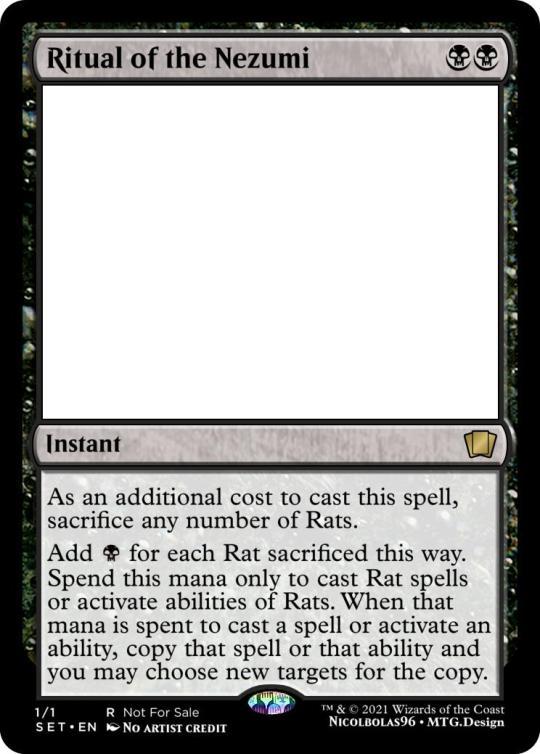
@nicolbolas96 - Ritual of the Nezumi
This card is another great example of using a tribe to limit the impact of an otherwise potentially very dangerous effect. There are certainly some good rats out there, but it’s a very narrow set as a whole, and limited in the sorts of things that appear on the cards. I also like that this card heavily encourages spreading the mana out over several rats or rat-abilities. There may not be much in the way of specific reasons for this card to work with rats rather than with some other tribe (although there are some decent rat token generation options), but rats do fall in the window of being plentiful enough and interesting enough that a tribal card that only works with them is interesting without being so omnipresent that a ritual that also functions as a spell copier is dangerous.
Black hasn’t gotten many mana-positive rituals recently - Culling Ritual is the last new one I know of, and may be the only one in Modern. It’s still nominally in Black’s pie as of the most recent Mechanical Color Pie article when some other cost is involved, however, so this card seems fine.

@nine-effing-hells - Nature’s Majesty
“Power four or greater” is a theme they’ve used a couple times in RG, and that’s also where similar themes often live. This card extends that to blue; I’m assuming that this appears in a wedge product where the theme lives in those colors and where the referenced creature types also are prominent there. In that context, it makes a lot of sense, and clearly spells out a path for a deck.
This card does something that a few multi-tribe submissions do, which is to require colors that one of the tribes isn’t likely to be playing in a dedicated tribal deck. There are technically a few blue plants, but a plant deck that wants to play this plant tribal card is probably mono-green or green-black. That said, the pool of plant cards that trigger the effect to begin with is pretty small, so barring new plants being released alongside this card, this is probably mostly for beast and elemental decks to begin with.
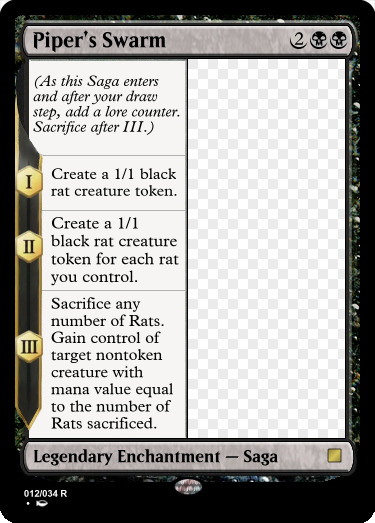
@pocketvikings - Piper’s Swarm
Rats were a popular tribe option for this contest. Rats don’t have a terribly strong tribal identity - they’re kind of good at making tokens, some of them have discard effects, etc., but there’s not really a specific iconic thing that rats do. This card cleverly references a single existing and flavor-driven Rat card, Piper of the Swarm. This card can’t be anything but a rat tribal card - if you replace it with a different creature type, the reference is lost.
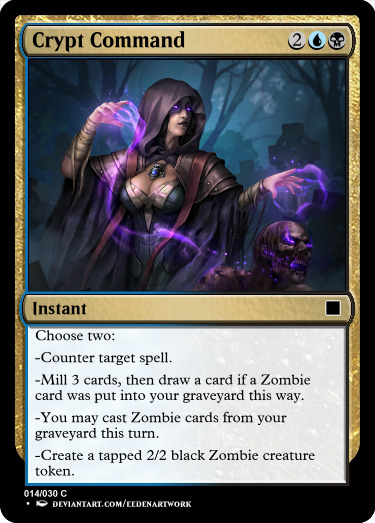
@rasputingold - Crypt Command
I’m assuming that this card, like other existing commands, is meant to be a rare; it’s pretty complex and overbearing for a common. The base rate on this card is pretty good - four mana to counter a spell and make a 2/2 is solid. There is a little friction between the first and third abilities, in that the first ability is more likely to be used on not your turn or during your end step, when the third ability is useless, but it’s not a total nonbo, and it’s fine if not all mode combinations are reliably good.
Normally, if one mode of a command targets something that has a good chance of becoming an illegal target while the command is on the stack, then all of the modes target, so that the spell doesn’t fail to resolve if one of its targets becomes illegal. Ojutai’s Command suggests that spells (or at least creature spells) are not considered likely enough to become illegal targets that that’s a concern, so this spell is probably in the clear. (There’s an argument to be made that spells that target are more likely to become illegal targets if what they target is removed.)

@reaperfromtheabyss - Dusk Beacon
I’m not 100% sure what this card represents, but it’s a good all-around support card that any tribe could make use of. The primary tribal identity of Scarecrows in Shadowmoor block is supporting and being supported by non-colorless creatures and aside from that they’re sort of generally just small artifact creatures, but this card does have specific synergy with Scarecrone and The Reaper King, who are probably the most popular scarecrows, and who are among the most worth actually building around. Menace is a nice choice of keyword, as it’s a fairly scarecrow-y keyword, but no printed Scarecrows have it.

@shakeszx - Negotiated Services
I’m assuming the decision to make this card symmetrical (rather than asymmetrical, like almost all modern tribal effects) was intentional, and I think it’s kind of interesting if that’s the case, because the drawback is large enough to serve as a meaningful hoser. The card only ever really goes in Rogue/Mercenary decks, but it makes more sense as a symmetrical card than most tribal effects do. I’m not sure if this interaction is quite worth breaking the modern default of this sort of design being asymmetrical, but it makes a decent argument for it.

@snugz - Fiendish Omens
Batching these three types together makes a lot of sense; Rakdos the Showstopper does it, and it feels like a well that’s natural to return to. Red and Black don’t get this sort of effect terribly often, but it’s reasonable for things that are in their colors, I suppose. This could arguably dig a little deeper; a set would have to be very heavily focused on these creature types before you could build a deck where this rarely whiffs, and I think you need this to rarely whiff for it to be worth including.
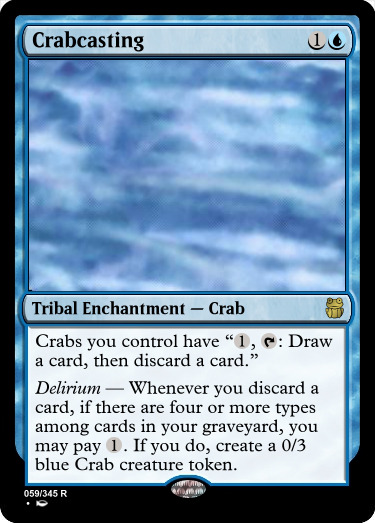
@starch255 - Crabcasting
This is presumably a crab so that it can use its granted ability itself. An enchantment granting itself a tap ability is a little odd; while this is an interaction that exists in the game across multiple cards (E.g., Joraga Treespeaker and Prowess of the Fair), putting it on a single card feels like it’s pushing into Future Sight design territory, and creeping on one of the few remaining distinctions between artifacts and enchantments. The card itself does a great job playing into the mill identity that crabs have sort of picked up against all odds.

@takemuse1 - Age of Trax
This card is a very cool lore cut - The Age of Trax is an era of Theros’s history when Archons ruled as tyrants before being overthown by Kynaios and Tiro, with the help of the gods. The card itself recalls the abilities of several notable archon creatures, which is cool. The card is a bit on the wordy side; that’s nothing new for Sagas, but this one may have more total text than any currently printed Saga. The first ability may be able to lose the part about playing Archons from your hand; the card still lightly encourages Archon tribal through the second ability. The last ability may also be a bit of a reach in white; white gets symmetrical card draw, but I’m not sure if the other abilities are something that appears much in white.
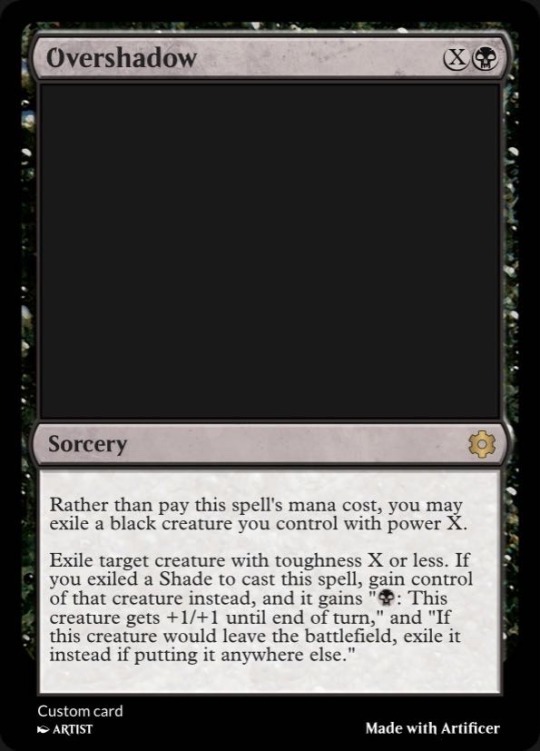
@wilsonosgoodmcman - Overshadow
The card name here is extremely clever, and helps sell an otherwise somewhat improbable combination of abilities. There’s some synergy between a Shade’s ability to pump itself and the mechanics of the card (and some non-synergy with most Shades’ very low non-pumped stats, which helps control the card’s power level), but the name pun really helps it cohere.
Behind everything else, this is a fairly powerful card, as a free removal spell, even if you’re not using the Shade part.
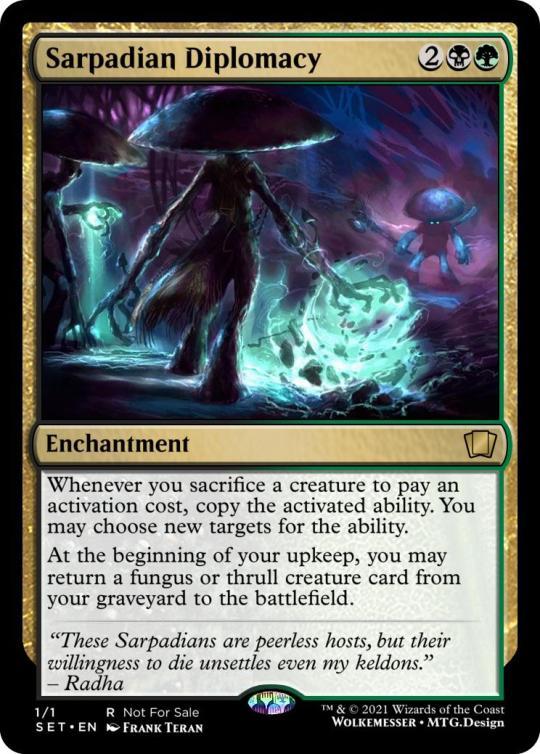
@wolkemesser - Sarpadian Diplomacy
This card has a clever, novel, powerful ability on it - powerful enough that I’m not at all confident how much this card should cost. It’s a very good combo with lots of things, but most of the things that’s a very good combo with are cards that are already a very good combo with lots of things.
Finding a mechanical tie between two creature types that have a flavor tie helps the card feel cohesive, and I think it’s interesting that the two referenced types interact with sacrifice in different ways. (Many funguses with sacrifice abilities sacrifice other things, while thrulls sacrifice themselves.)
That said, there is one hitch with this card - it’s substantially more natural in a Fungus deck than in a Thrull deck. A Thrull deck that wants to play this Thrull tribal card has to include green, which it otherwise has no particular reason to do.
The card also supplies a recurring blocker for no mana investment. although its status as a rare means that that’s not as much of an issue.
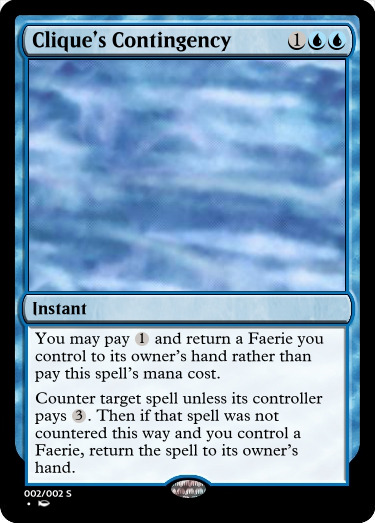
@yourrightfulking - Clique’s Contingency
This card packs a lot of different decision points into a relatively tight package, especially if the player controls exactly one faerie. The nods to what faeries do as a tribe aren’t super loud, but the card fits with the general faerie game plan, and certainly feels trickster-y.
There are enough non-blue fairies that this card does represent counterspell access in non-blue decks. That could be considered a bug or a feature, but the “safe” version of this card would probably cost U if you returned a fairy. That said, while Bitterblossom and certain Changelings do make it into non-fairy decks, realistically any deck that’s considering this card is likely playing blue.
9 notes
·
View notes
Text
23 Fentuary, 5A 169: Today I Fucked Up
As soon as it’s light, I take advantage of the fact that the sea remains calm to get back to where I left Erjolf and bring him the Muspah tail. Sure enough, he’s there waiting for me, or, more specifically, waiting for the trophy I’m bringing back. Well, I show it to him, and he gets excited! Rather than thank me, though, he asks me to keep this whole business on the down low, just in case the Fremennik elders find out that he didn’t score this trophy alone and make him do the rest of the trials in the usual manner. Given how he sponged on me this entire time, I tell him I can make no promises.
Well, he heads off to Rellekka to become a Fremennik, and I’m left trying to decide where I want to go next. One thing I could do is check in with the natural historian, and tell him that the Muspah sighting was… not of an actual Muspah at all. He’s disappointed by this, but I manage to fire up his excitement again by telling him where the Varrock museum might find that Muspah statue I unearthed in the desert. Pleased, he gives me a spirit lamp he’s been keeping around. I inhale… and am treated with brief flashes of visions of a craftsman at work. Interesting.
Since I’m already here in the Fremennik Province, I get it into my mind that I might want to see if the ban on entering the city has been lifted yet. So, I go through the mountainside tunnel and down to the river Kelda, and inquire about passage at the ferry dock. The ferryman is most obliging, explaining to me that the Consortium’s travel ban has cost them a lot of business, so they decided to rescind it, and are even allowing humans to travel in and out of the city for free, to make up for lost custom!
The boatman starts up the paddlewheel on the boat and casts off. Once we’re floating down the river, he tells me about the history of Keldagrim. It’s been 500 years, he says, since the reign of King Alvis, known to history as the saviour of Keldagrim and the victim of his own inventions. He explains: The King federated the city’s mining companies into a body called the Consortium, which was meant to serve the monarchy. But in time, it was the monarchy that became subordinated to the Consortium. Now, Keldagrim has no kings, and only the statue of King Alvis stands to remind its people of the old days, the dark days of monarchy.
The statue is right there on the approach to the city! We would be passing it, but as we approach, the engine of the boat emits a disconcerting noise and the craft begins to veer erratically hither and thither. And then the prow crashes into the statue and it falls into the water, shattering into fragments. Well, shit. What a start to my visit.
It gets worse, though: the moment we dock, a squad of Black Guards in gold-trimmed armour runs up and places us under arrest. I am separated from the ferryman and dragged to the guard’s headquarters, where its Commander, Veldaban, interrogates me. Or, rather, he wants a chat. See, it turns out I’m not actually under arrest: the statue was due for replacement anyway, and besides, it’s the ferryman’s damn fault for losing control of his boat. Still, he says, it would be good if I helped in the effort to recreate the sculpture, working as the assistant to Blasidar, Keldagrim’s finest sculptor. His workshop is on the eastern side of the Kelda. I reply that I’d be more than happy to help, which pleases Veldaban.
Before I go off to explore the city, I hang around the Black Guard HQ for a bit, even stealing a few words with the Supreme Commander, a black-bearded dwarf named Bisi. I ask him about his relationship to Veldaban, and he explains that, while Veldaban commands the Black Guard in Keldagrim (by far the largest command), he oversees all the Black Guard regiments all over the dwarven realm. For instance, Commander Lawgof is of equal rank to Veldaban, and subordinate to Bisi. Aha, that makes sense. I ask Bisi whether he’s heard any news around the city. Of course, he says, the biggest and latest news is the collapse of the statue, but he can’t shake the impression that it’s somehow connected to the other disturbances that have taken place around here recently. The ones that led to the city’s closure. Hm, if there’s anything to that theory, perhaps I shall find out as I work to rebuild the statue.
For now, though, I have a city to explore! Keldagrim is a marvel to behold, a city the size of Varrock built free-standing in a massive, vaulted cavern. The buildings are dour, squat affairs of grey stone reinforced with metal that exude solidity, and the streets are brightly lit with lantern-light. A remarkable place, but very, very dwarven. Even the heights of the storeys in the buildings are all wrong, my head bumping almost up against the ceiling of most of them.
I begin my tour of the city by walking about the western side. The first building that captures my attention is a small armour-shop run by Saro, who stocks it with high-quality wares— even adamantium, which is rare in human lands except by special order from the Grand Exchange. It would seem he’s working on something even better, a system of lightweight metal plates meant to increase the durability of armour, but all he’s got now is prototypes, and they’re extremely expensive.
The building next door is something of a dwarven stereotype: an inn called the King’s Axe, serving up dwarven stout to dwarves in search of the good stuff. I don’t know whether it’s the time of day (do dwarves living underground follow a day-night sleep cycle?) but it’s pretty empty right now. Still, I have a glass of dwarven stout along with a fun-loving dwarf named Gauss. After I’ve finished my pint, I go looking for the innkeeper to inquire about lodgings. He offers me a room, and lets slip there’s a gnomish delegation staying at the inn right now, come to negotiate with a cartel known as the Red Axe. I’m in pretty good stead with the gnomes, so I decide to have a chat with them. They are pretty aloof and standoffish, more so than most gnomes, though I figure they may be some of Glough’s flunkies. After talking to them for a while, though, I get the feeling that there’s something more sinister going on: I ask both gnomes I meet where they’re from, just casually, and they give me two different answers! The official story is that they’re from the Grand Tree, getting much-needed supplies of an unspecified nature, but the junior of the two delegates tells me they’re from Tree Gnome Village and is instantly corrected by her superior. I don’t know what to make of it, and can’t think of any way to press them into telling me the truth, so I move on.
Along the street to the south-east, I stop by a stonemason’s workshop to see whether he would consider selling stone to a human interested in furnishing her house. He tells me he sees no problem with that, and walks me through the varieties of stone he’s selling, from common limestone to vastly expensive magic stones.
On the same street is one of the entrances to the former royal palace, a grand hall that dominates the skyline and straddles the river. On this side, there are the gardens (a rather shabby affair by surface standards, with only a few fly-eating cave plants and an unkempt soil-bed), where I run into an uncommonly tall dwarf named Tombar (not really the talkative sort, though) and Rind, the palace gardener, who talks to me about the intricacies of growing anything so deep beneath the mountains. I ask him where the dwarves get their food supply, and he tells me they can grow a bit here, but most of Keldagrim’s food comes from trade via the mine cart tracks that run deep beneath the earth to various outposts. In the Era of Kings, though, technology was more primitive, and the food situation was worse, but the dwarves never considered abandoning the underground. I ask him why that was, and he replies that food shortages were preferable to being in the thick of the God Wars. This state of affairs continued well into the Fourth Age, and only after King Alvis’ glorious victory over the mountain trolls did the dwarves send scouts to the surface to check on the situation.
On the northern side of the west bank, I find a bank, staffed by dwarves but fully connected to the Bank of Gielinor network. Quite convenient! Further on, I make a few more stops. For instance, there’s a store selling quality weapons that even has runite longswords in stock: quite remarkable given the rarity of the metal. I also pop into some private dwellings to ask the locals what the gossip around town is. It doesn’t go too well. Some, like a certain Dromund, tell me to get out, and others, like a quarrelling dwarven couple, are too absorbed in their own quibbles to spare me any time. Fortunately, there’s a library nearby, and the librarian, Hugi (the name means ‘personification of thought’ in Dwarven) is pleased to have someone to talk to. I ask him about the collection, and he says it’s been accumulated over centuries, from the Era of Kings, to the Rise of the Consortium, to the present day, the Era of Prosperity. I glance through the books, but find nothing so exciting that I would put aside my exploration of the city to ensconce myself with it, so I make small talk with a human researcher— the first human I’ve seen in the city besides myself— then continue on my way.
Rather than visit the palace, which I expect will take a long time, I decide to cross over to the east bank via a bridge just upriver and look for the stonemason’s workshop. On the banks of the Kelda, I notice a section of the cavern wall that positively gleams with rare ores. I try to take a closer look, but a dwarf stops me, saying I’m trespassing on public property. Okay, fair enough: access to all that ore would have been too good to be true.
East Keldagrim is a bit of a different world from the west bank. The buildings here are smaller, shabbier, working-class. There is no public street-lighting, only lanterns hung from houses, and even the street is a bit of a foreign concept. Right by the bridge is a dock where I run into that damned ferryman and his boat. I give him a piece of my mind about his shoddy piloting, but he doesn’t seem fazed; he just caustically reminds me that I got my money’s worth for the journey. Grr.
I don’t know if it’s just my imagination, but the locals around here seem to be friendlier than the well-heeled lot over in West Keldagrim. There’s this one dwarf, Karl, for instance, who’s not angry at me for knocking on his door, but listens raptly to my firsthand account of the collapse of the statue and my subsequent arrest. Then, to the north of his place, there’s a shop selling kebabs, whose owner complains to me about some particularly drunken dwarves who live in the area. In fact, I run into one of them soon afterwards: as I’m passing by his house, he throws an empty bottle in my direction! I barge in to confront him, but see that he’s drunk well past the point of throwing the bottle maliciously: he’s hallucinating about dwarf-eating kebabs that have arrived to invade the city! Oh dear, I hope he will be all right.
On the far eastern edge of the city are the actual slums, little dwellings carved straight out of the rock, interspersed with some actual buildings. In one of the buildings, I find a dwarf selling decorative armguards, but he won’t sell to me, because apparently they’re not the right look for my arms (I don’t have forearms the size of a tree branch!). Oh well, should probably have seen that coming. Behind his house is a small coal mine where some of the locals from the cave-homes make their living. They say I can mine there as long as I don’t draw too much attention to myself. Alright, good to know.
The colourful sociological observations don’t end there. One of the locals is a dwarven male wreathed in smoke, who looks completely out of it. Is he doing some kind of drugs, I wonder? There’s also the mostly-deaf owner of a pickaxe shop, who sells remarkable-quality wares (even runite picks) but is burdened by his son, who is supposed to be helping him run the business but is actually kind of a layabout. I also encounter a dwarf who’s wallowing in self-pity because after ninety years mining, all he’s got is a small house on the east bank. I would tell him to count his blessings— it doesn’t seem like too bad a life— but I doubt he’ll listen, so I leave him be.
Further south, the character of the district turns from residential to industrial, with a number of important enterprises all located close to one another. There’s the lava flow mine, for instance, which is off-limits to humans but provides geothermal power for the mine cart network, so is of crucial importance to the functioning of the city. Then there’s a brewery, which advertises its alcohol by way of a drunken dwarf who walks around with a placard: apparently this is the only job he could get after being fired by the Red Axe for… not showing up to work in uniform one time too many, the brewer believes? Anyway, their profit margins are low, so they pay him in beer. I ask the woman at the bar if I can use the brewing facilities for my own purposes, and she tells me to go ahead: her husband Blandebir will charge me an appropriate amount for the yeast. I have it in mind to brew some cider, and unless I take another trip to Morytania (which, actually, I well might) this would be a decent place to do it. But for cider, I’ll need apples, and I don’t have enough right now to make any. What else? Oh, the brewery has a cat, but it’s big and mean and even when I speak to it in cat through my amulet, it just glowers at me.
South of the brewery is the rail yard, a sprawling tangle of mine cart tracks that spreads its tentacles to all corners of the dwarven realm. The main trunk line goes all the way to the Grand Exchange in Varrock, with a through stop at the Ice Mountain mines. I ask a conductor how much it would cost for me to travel by mine cart and learn that it is free for humans: another part of the city’s bid to get business booming again. Very useful stuff, though I still have a statue I’m duty-bound to rebuild before I feel I can leave.
Right by the rail yard, I notice a large factory building of some kind. The foreman outside isn’t very communicative, but he lets me know that this building houses the blast furnace, which the Consortium has opened up to all and sundry (even non-dwarves, which he’s displeased about) so that it can secure the manpower needed to run it. Since no one is stopping me from going inside, I head in and try my luck talking to the dwarves inside to find out more. The shop floor workers aren’t much help, but I finally manage to convince a foreman to talk to me. He tells me that the blast furnace is the pinnacle of dwarven metallurgy, cutting in half the amount of coal needed to refine ore. The downside is that it takes a five-man crew to get the thing going, and since management refuses to pay workers anything (they argue it’s a privilege even to be working on this technological marvel!) the furnace runs idle a lot of the time and requires human volunteers at all others. I question the logic of this business strategy, but hey, if it works for these guy, who am I to question it.
A few other dwarves are hanging around the blast furnace to support operations. One of them is an ore merchant, who sells large quantities of ore of various kinds (nothing rarer than mithril, though) to smiths who didn’t bring, or cannot procure their own; the other, meanwhile, is a quartermaster for the Black Guard, who buys top-quality armour from smiths who can’t be bothered to market the wares they produce here. Since the furnace isn’t running right now, though, his stock is all empty. Well, there’s nothing really for me to do here, so I go out again and look for that sculptor.
I find his shop right by the eastern entrance to the Consortium palace. Blasidar is a middle-aged dwarf with a greying beard who greets me with courtesy, but no special warmth— but that’s only to be expected from the dwarves, really. I tell him why I’m visiting him and ask whether there’s anything I can help with as far as rebuilding the statue goes. Blasidar thinks for a bit, then tells me he’s already got an assistant and a model, but could use an errand girl. I tell him to go on. He explains that his brief was to rebuild the statue exactly as it was, but, the dwarves not having much of a painting tradition, there exists no visual record of it. So, we’ll have to make do and produce a plausible facsimile using ornate, but probably ahistorical clothes. Specifically, he wants me to find a pair of boots, the fanciest I can find; robes in the royal style; and King Alvis’ axe, which is said to still survive. He has no idea where in Keldagrim I can find these items, but wishes me best of luck anyway in finding them.
That’s… more of a challenge than I expected. But I shall try to make some headway tomorrow (or at least, after I’ve had what would be a full night’s sleep above-ground). I’ll begin at the King’s Axe (I’ve a feeling the inn I’m staying in has that name for a reason) and move on to the Consortium palace: if there’s one place that’s bound to have rich dwarves and fancy clothes, it’s there.

0 notes